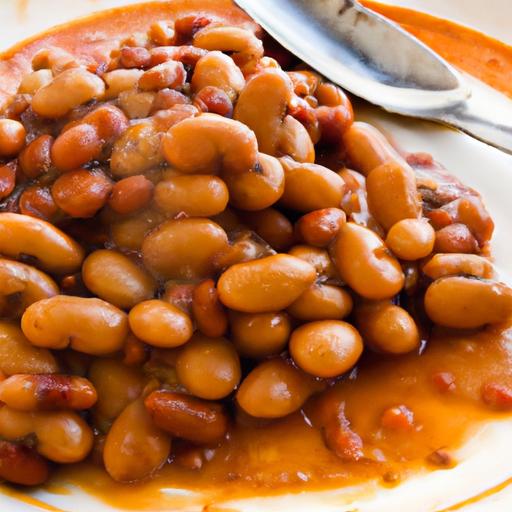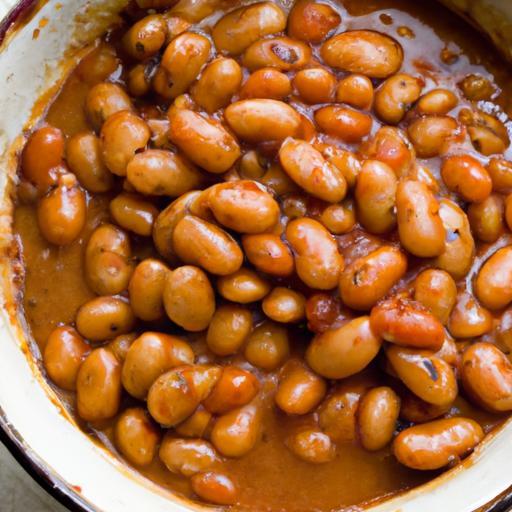Baking beans may seem like a humble kitchen task, but behind every spoonful of those tender, flavorful morsels lies a fascinating blend of science and artistry. From the chemistry that transforms tough legumes into velvety softness, to the alchemy of spices and sweeteners melding into a harmonious glaze, perfect baked beans are a culinary symphony grounded in precise technique and understanding. In this article, we will peel back the layers of tradition and explore the scientific principles that turn simple beans into a beloved comfort food classic, revealing how temperature, timing, and ingredients come together to create that irresistible, mouthwatering magic.
The Science Behind Crafting the Perfect Baked Beans begins with understanding the subtle alchemy of bean selection and preparation-a transformative journey that turns humble legumes into a soulful, hearty dish bursting with nuanced textures and rich flavors. Whether you’re drawn to the creaminess of navy beans or the hearty bite of kidney beans, each variety brings its own character, influenced by starch composition and moisture retention. Unlocking the secrets to optimal cooking times and textures ensures every bean is tender but intact, creating a dish that’s both comforting and sophisticated.
Prep and Cook Time
- Preparation: 20 minutes
- Soaking: 8 hours (overnight)
- Cooking: 2 hours 30 minutes (slow simmer)
- Total Time: Approximately 11 hours (including soaking)
Yield
Serves 6-8 generous portions
Difficulty Level
Medium – requires patience and attention to detail for the perfect balance of texture and sauce
Ingredients
- 2 cups dry navy beans, rinsed and soaked overnight
- 6 cups water, plus extra for soaking
- 4 slices thick-cut bacon, diced
- 1 large yellow onion, finely chopped
- 3 cloves garlic, minced
- 1/4 cup pure maple syrup
- 1/4 cup molasses
- 1/4 cup tomato paste
- 2 tablespoons Dijon mustard
- 1 tablespoon apple cider vinegar
- 1 teaspoon smoked paprika
- 1 teaspoon kosher salt
- 1/2 teaspoon freshly ground black pepper
- 1/4 teaspoon ground cayenne pepper (optional)
- 2 cups low-sodium chicken broth or vegetable broth
- 2 tablespoons olive oil
Instructions
- Drain and rinse the soaked navy beans thoroughly. Place in a large pot and cover with fresh water. Bring to a boil, then reduce to a gentle simmer. Cook uncovered for about 45-60 minutes until beans are just tender but not falling apart. Drain and set aside.
- Preheat a large Dutch oven over medium heat. Add the diced bacon and sauté until crisp and the fat renders, about 7 minutes. Use a slotted spoon to remove the bacon, leaving the rendered fat in the pot.
- Add olive oil to the bacon fat if needed, then toss in the chopped onions and garlic. Sauté until golden brown, about 5 minutes, stirring frequently to develop those caramelized, rich undertones essential for depth of flavor.
- Stir in the tomato paste and cook, stirring constantly, for 2 minutes. This slight Maillard reaction on the tomato paste significantly enhances the sauce’s complexity, building subtle roasted notes.
- Add the maple syrup, molasses, Dijon mustard, apple cider vinegar, smoked paprika, salt, black pepper, and optional cayenne. Stir to blend, then pour in the chicken broth and bring the mixture to a simmer.
- Return the cooked beans and crispy bacon to the pot, gently folding to combine without breaking the beans. Reduce heat to low, cover partially, and simmer slowly for 1 hour. Stir gently every 15 minutes; the sauce should thicken to a luscious, creamy consistency clinging to each tender bean.
- If the sauce becomes too thick, add small splashes of broth or water-this balance of moisture is key to the ideal saucy texture, neither soupy nor dry.
- Taste and adjust seasoning before serving. The flavors will continue to meld, so a final brightness from an extra splash of vinegar or a pinch of salt can bring everything into perfect harmony.
Tips for Success
- Bean selection matters: navy and great northern beans offer creaminess; pinto beans bring earthiness and hold shape well.
- Soak overnight for more even cooking and to reduce gas-producing sugars.
- Maintain a low simmer for tender beans; high heat risks splitting the skins and creating an inconsistent texture.
- Layer flavors: the Maillard reaction on onions, bacon, and tomato paste adds savory depth critical for authentic baked beans.
- For a vegetarian version, substitute mushroom broth for chicken and use smoked paprika for that smoky essence without bacon.
- Make ahead: beans improve overnight as flavors meld-gently reheat and adjust thickness before serving.
Serving Suggestions
Baked beans are a quintessential comfort food that shine alongside rustic cornbread, grilled sausages, or slow-roasted pork shoulder. Garnish with fresh chopped parsley or scallions for a pop of color and brightness. A dollop of tangy sour cream or sharp cheddar grated over warm beans can elevate the richness even further. For a summer twist, serve chilled atop a crisp garden salad with a drizzle of smoky chipotle vinaigrette.

| Nutrient | Per Serving |
|---|---|
| Calories | 280 kcal |
| Protein | 15 g |
| Carbohydrates | 40 g |
| Fat | 7 g |
For more on pairing beans with complementary dishes, check out our side dishes for baked beans. To dive deeper into the Maillard reaction and its culinary magic, visit this insightful overview from Science Daily.
Q&A
Q&A: The Science Behind Crafting the Perfect Baked Beans
Q1: What makes baked beans so irresistibly delicious?
A1: It’s all about the chemistry of flavor and texture! The magic happens when heat, sugar, acid, and protein dance together. Slow cooking allows the beans’ starches to soften and meld with the sauce, while caramelized sugars and tangy acids create a complex, comforting depth of flavor that hugs your taste buds.
Q2: Why is the choice of beans important?
A2: Navy beans or great northern beans are the classic stars because they hold their shape but become tender when baked. Their relatively thin skins let flavors in without turning mushy, striking the perfect balance between hearty texture and creamy softness.
Q3: How does soaking affect baked beans?
A3: Soaking primes the beans for even cooking by softening their tough outer layers and reducing cooking time. It also helps leach out some of the indigestible sugars that cause bloating, making the final dish gentler on your tummy.
Q4: What roles do sugar and acid play in the recipe?
A4: Sugar isn’t just sweet-when it caramelizes, it adds notes of toffee and depth. Acidic ingredients like tomato, vinegar, or mustard provide brightness that cuts through the richness, balancing sweetness and making the sauce sing with vivid flavor.
Q5: Why is slow, low-temperature baking crucial?
A5: Slow baking lets flavors marry gradually. High heat can break down beans too quickly, turning them mushy or causing the sauce to scorch. The gentle heat encourages starches to gelatinize slowly, creating that luscious, velvety texture baked bean enthusiasts crave.
Q6: Can the science of seasoning elevate baked beans?
A6: Absolutely! Beyond the basics, salt enhances natural flavors and helps proteins in the beans gel at just the right level. Spices like smoked paprika, cumin, or chili powder introduce exciting aroma molecules, stimulating your senses and elevating the humble bean to a culinary showstopper.
Q7: Is there a secret to that iconic “baked” flavor?
A7: The secret lies in Maillard reactions-those beautiful chemical processes between amino acids and sugars during slow cooking. This browning creates rich, savory, and nutty notes, giving baked beans their signature depth and irresistible smell.
In essence: Crafting the perfect baked beans is a fascinating interplay of biology, chemistry, and a pinch of culinary artistry. Understanding these scientific principles can transform your next batch from simple comfort food into a flavor-packed masterpiece!
In Summary
As the aroma of simmering beans fills the kitchen, we come to appreciate that crafting the perfect baked beans is far more than a simple recipe-it’s a delicate dance of science and tradition. From the Maillard reaction that deepens flavor to the slow caramelization of sugars that add sweetness, every step is a purposeful experiment in transforming humble legumes into a comforting masterpiece. By understanding the chemistry behind texture, taste, and tenderness, we unlock the secrets to a dish that has delighted palates for generations. So, the next time you savor a spoonful of baked beans, remember: behind that hearty, rich flavor lies a world of science patiently simmering in every bite.


